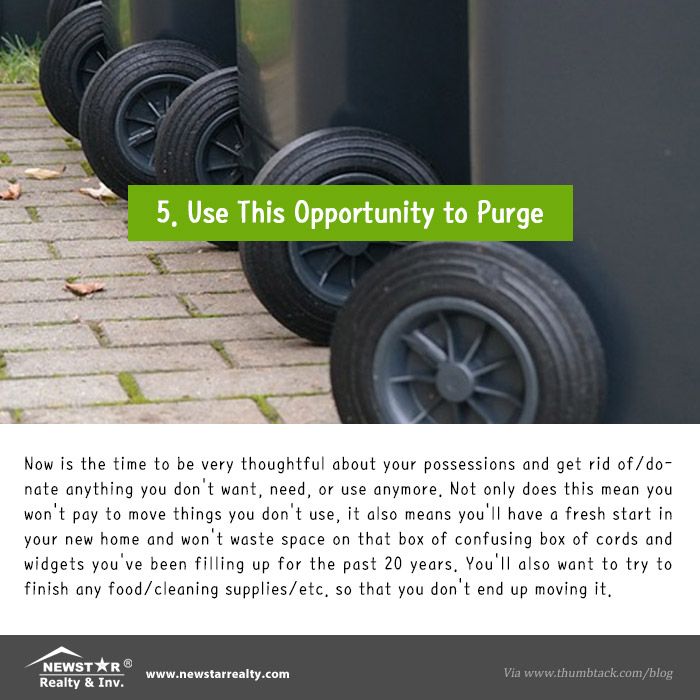10 Tips for a Stress-Free Move
The Safety Benefit of Smart Homes

The latest technology doesn’t just make properties more marketable. Learn how to use these smart devices to thwart danger when you’re out in the field.
Sure, smart-home devices can make a property more desirable, but have you considered how they can keep you safe as a listing agent or when showing homes to buyers? Open houses and vacant properties are the top places where real estate professionals report encountering threatening situations, according to the National Association of REALTORS®’ 2016 Member Safety Report. Tara Christianson, technology and training director at Century 21 Redwood Realty in Arlington, Va., recently hosted a webinar and offered tips on how smart devices can protect your client’s property and yourself.
- Smart door locks and keyless entry systems can help keep a vacant property more secure. Products such as Schlage’s Bluetooth-enabled locks not only allow you to control access to the property but also can record traffic in the home. You can create e-keys for contractors, assistants, and your real estate team members.
- Video doorbells, such as SkyBell, contain video cameras so you can talk to whoever is on the other side of the door without even being on the premises. The video streams to your phone, and some products even allow you to take a photo of the person at the door to send to authorities if you become alarmed.
- Motion sensors are helpful for both vacant homes and new construction — both properties squatters tend to target. Fibaro, for example, sends activity alerts to your phone when there is movement in the home. You can set alerts to the times you expect the home to be empty. “Maybe someone’s in the home that you need to be aware of so you know to bring someone with you when you arrive,” Christianson says.
- Use devices that monitor doors and windows so you can tell when they’ve been left open. This will likewise alert you to suspicious activity at a listing, and these devices are useful for sellers as well so they can monitor their homes on days when they’re being shown.
- Smart lighting and entertainment systems don’t just help you set the ambiance for a showing. Systems like Hue and Lifx allow you to set on and off times for lighting systems, making it look like a listing is continually occupied.
Do Smart Homes Invite Threats?
Such technology can make a home more vulnerable to hackers, Christianson admits, but there are steps you can take to mitigate the risk. You should never use open Wi-Fi networks when operating smart devices. If your client’s network is less secure, you can protect your own device with a virtual private network, which creates an encrypted connection when using your client’s Wi-Fi. But if you’re going to use a device in a seller’s home, you should always ask them how protected their network is. Do they have a password that’s hard to guess, or are they using a simple code like “123” or “password”?
Give Clients Smart Advice
Steer clients interested in smart devices toward well-known vendors such as Nest, which is backed by Google. “Sometimes, products or companies sound great, but then the vendor stops updating their devices or shuts down without notice,” Christianson says. “You don’t want your client to be stuck with something that suddenly stops working.”
Tell your sellers to disclose what smart devices they have in their homes to buyers up front. That will absolve them of any responsibility in case a buyer has a complaint about being monitored during a showing. “You don’t want conversations with buyers caught on tape without their knowledge,” Christianson says. Let informed buyers make their own decisions about whether they want to even enter rooms that have active recording devices.
When different is BETTER
How to Deal with a Deadbeat Landlord

What do used car salesmen, lawyers, and landlords all have in common? … People in all three professions are often the butt of jokes about—shall we say—low ethics.
Here are some jokes I’ve heard recently:
- What’s the difference between a good lawyer and a bad lawyer? … A bad lawyer makes your case drag on for years. A good lawyer makes it last even longer.
- I saw the most beautiful cars in the window of a dealership. A salesman came out and said, “Come on in. They’re bigger than ever, and they last a lifetime!” … Later I discovered he was talking about the payments.
- What do landlords do for fun? … How would I know? I haven’t seen mine in the past eight months.
Those jokes you hear are often unfair, but what makes them funny is the kernel of truth associated with them. And unfortunately for all the great, honest, just-trying-to-make-a-living landlords out there, the deadbeat landlord gives all of us a bad name.
So, just to show that all landlords are not untrustworthy villains, I would like to do my part by helping all the tenants out there who are stuck with a deadbeat landlord, meaning a landlord who is good at collecting the rent check and nothing much else.
There’s a Problem, and Your Deadbeat Landlord Has Disappeared
You won’t know you have a deadbeat landlord until a problem arises. The most common problem tenants have are maintenance ones. So what should you do when you notify your landlord that:
- The heat went out during the winter (or the AC in the summer),
- A window won’t lock,
- Bugs are running around your kitchen,
- Or any one of a number of possible problems
…and your landlord is M.I.A.?
First of all, here’s what you shouldn’t do: You should not withhold rent. Doing so could get you evicted.
Some tenants think that if the rental unit has a problem that means they don’t have to pay rent. If you stop paying rent, you will probably hear from the landlord—but not to fix the problem. It will be to evict you.
You do not have to live with a problem, either. There’s a concept in the law called the “implied warranty of habitability,” meaning that your landlord has to keep the place livable. Note that livable pertains to necessities, such as running water, not because you can’t bear the olive green walls.
The Appropriate Steps
Here’s what you should do if there’s a problem that needs fixing:
1. Make Contact (and document it)
Contact your landlord as soon as you notice the problem. A good landlord will respond right away, and will take care of the issue. But, since you have read this far, you probably have a deadbeat landlord, and you are being ignored. So go to step 2.
2. Send a Certified Letter
Send your landlord a certified letter if they don’t respond to your first request. State the nature of the problem, and the date it started happening. You’ll need to have this documented in case you need to take further action, so make a copy for yourself as well.
3. Wait
Wait to see whether your landlord responds. Tenants typically need to give their landlord 30 days to fix a problem that is not an emergency. But emergencies need to be addressed immediately.
4. Allow Access
If your landlord responds, let them (or their representative) in to make the repair.
5. Try to “Repair and Deduct”
If your deadbeat landlord still ignores the situation, there’s more you can do. Try the repair-and-deduct method if your jurisdiction allows this. You would arrange for a repairman to fix the problem, and you would then deduct the cost from the rent. Provide your landlord with a receipt.
6. Call the Authorities
Call your local health or building inspector. Someone will inspect, and that could force your deadbeat landlord to act.
7. Withhold Rent
I know I said not to withhold rent earlier. But there might be an instance where you can. Find out whether your state allows this, and if so, under what conditions. What you’d typically need to do would be to set up an escrow account, and put the rent in it. Let your landlord know that you’re putting the rent payment in an escrow account and will release the funds after the repair is made.
8. Break the Lease
If your rental is truly uninhabitable, and your deadbeat landlord won’t do anything to fix it, you might be able to break the lease. But first check with an attorney or legal aid for your area to see whether you have a case.
You Might Not Have a Deadbeat Landlord
Although you are entitled to have your landlord fix major problems, such as no heat, no running water, and a pest infestation, you are not necessarily entitled to have nonessential problems fixed, such as a leaky sink. Read your lease to see whether it addresses minor repairs, how those are handled, and whose responsibility they are. You might need to change out that lightbulb yourself.
Also consider that if you caused the problem, you need to fix it. If your hair clogged up the sink, you need to fix that since you caused the problem. If the landlord fixes a problem you created, they can deduct the cost from your security deposit.
Conclusion
You don’t need to put up with a deadbeat landlord. Try the steps listed here. If you have a deadbeat landlord story of your own, share it in the comments section, along with what you did to solve the problem!
Credit to Laura Agadoni
Laura Agadoni is a landlord and journalist whose articles appear in various publications such as Trulia, The Houston Chronicle, The Motley Fool, SFGate, Zacks, The Penny Hoarder and azcentral.

Don’t Be the Reason Your Clients Break Up

Like most people, real estate agents want to feel the love — especially when it’s coming from clients. But in a stressful, emotional time, buyers and sellers are sometimes more likely to take their anxieties out on you than show their appreciation. You could be on the receiving end of an angry rant, peppered with questions that reveal a client’s lack of trust, or worst of all, the client could ghost you. You probably don’t see why they are so upset, but before you write your client off as crazy, try to figure out where their fear is coming from.
Every relationship needs good communication, and as a real estate agent, you need to be a master at it. If you don’t take extra care to communicate often and to all parties involved, you risk your clients feeling uncertainty, fear, and eventually anger. We live in a busy world, and clients may be distracted by their phones, kids, or other stressors. This is why we often find ourselves repeating things and answering the same questions multiple times. Here are a few things I’ve learned to do to perfect my communication with clients.
When you’re dealing with a couple or clients who are including others in their decision-making process, always copy all parties on emails about the transaction. This is why email is my favorite way to share important information — even if I’ve been texting with clients all day or I have them in a room face-to-face. If you put your thoughts in writing to everyone, you can refer back to the email if they start asking questions you’ve already answered. At the beginning of the transaction, give buyers and sellers a guideline and timeline of what to expect. Be clear about what happens when, and what they need to do to keep the transaction on track. For extra-anxious clients, this will be comforting to have on hand.
Don’t assume your clients are sharing everything with their spouse. If you’re working with a couple and maintain contact primarily with one of the parties, you shouldn’t assume they’re passing on the information you’ve given them to their significant other. It’s sad but true that people don’t communicate with each other. I often find myself on the phone or in person with one half of the couple, and we’ll discuss priorities, make decisions, and plan to move forward according to that conversation. But unless I explicitly communicate what has been discussed or decided to the other half, that person might never know. One email should be sent to both parties, going over the conversation you had with one of them and the next steps you will be taking.
When you’re working with an unmarried couple but only one is buying or selling, give them both equal priority — up to a point. Usually, I ask for both my client and their partner’s contact information, and I include them on emails regarding the home search or any information about showings. But I don’t include the partner on the specifics of the transaction. Since they aren’t officially part of it, it’s up to my client to share whatever they want with his or her partner. If you do include the partner in all that you can, though, you will make them an ally. They appreciate being seen and respected, even without an official stake in the transaction.
Be obsessively careful to balance communication with divorcing clients or an estate with hostile heirs. If one party of the transaction feels you are favoring another, telling secrets, or not working in everyone’s interest, they will make the entire transaction 10 times more difficult by questioning everything, refusing to compromise, or going silent on you. When hurt feelings are involved, someone always feels like they are losing the most — and sometimes everyone feels this way. It’s easier to speak primarily with the party that is kind, reasonable, and willing to negotiate, but it is essential that every communication you send is copied to all parties.
Also, be careful to not stir the pot, even unintentionally. For instance, in a divorce, one party may have moved out of the house. If the person who doesn’t live there anymore asks how the showings are going and if the soon-to-be-ex is keeping the house show-ready, do not reply and copy the other spouse on the email. Send a new email to both parties with the showing feedback you’ve received and a reminder that the property must be show-ready at all times. Keep your communication neutral.
We all have been guilty of not communicating with our clients as well as we should. Maybe they are past clients who are working with you again, so you figure they know how the process goes. Or they’re a couple who you assume must be sharing important information with each other. That’s when you get in trouble. When someone isn’t happy with your service, it’s all your fault. If you mess up, don’t try to talk your way out of it. Apologize sincerely. It goes a long way in making things right again.
Making Every Transaction Smooth
Stone Exteriors: Asset or Nightmare?

Traditional vinyl siding, long the go-to material for home builders, is increasingly being snubbed in favor of trendier manufactured stone products that may or may not contain any actual stone. The appeal of faux stone to builders and home owners is easy to understand: Fabricated stone or stone veneer exteriors are lighter weight and less expensive than natural stone and are offered in a wide array of colors and styles. Manufacturers have reported double-digit sales increases in recent years. But home inspectors are sounding off about the need for caution: Reports of water damage due to poor installation techniques have become widespread.
Home inspector Scott Patterson with Trace Inspections in Nashville, Tenn., says that in nine out of 10 homes he inspects with stone veneer siding, the product has been applied incorrectly. And home owners are reporting that water seepage behind the siding is leading to rotting walls and mold problems. Sometimes the problems don’t become evident for years after installation.
These damage reports related to manufactured stone sound eerily similar to those from the 1990s when synthetic stucco (also known as exterior insulation finish systems or EIFS) generated a lot of public attention. Like artificial stone, synthetic stucco was initially touted as a more affordable, versatile alternative to the genuine product. EIFS were also more crack-resistant than traditional stucco. Years later, home owners discovered water penetrating small openings around windows and doors, leading to costly repairs. Home owners filed lawsuits against manufacturers, and class action settlements resulted in affected home owners receiving generous payouts.
3 Ways to Protect Home Exteriors
Most siding materials require little to no upkeep. Brick, engineered wood, stone (both natural and manufactured), and fiber cement are thought to last for the life of a home, according to a report released by the National Association of Home Builders and Bank of America, “Study of Life Expectancy of Home Components.” But Frank Lesh, executive director of the American Society of Home Inspectors, offers some pointers you can share with home owners to help them protect their siding from damage, including:
- Keep foliage away. Make sure no plants are growing on the siding. “Plants can trap moisture and allow insects and animals to infiltrate,” Lesh says. “You want the siding to be exposed to the elements.”
- Watch where water may be getting in. Check areas around windows and doors to see if water is getting in. Moisture can linger and eventually cause rotting or fungal growth. Make sure those areas have been properly caulked or tuckpointed to prevent seepage.
- Keep the gutters cleaned. Many home owners think they only need to check for clogged gutters in autumn when leaves are falling. A neighbor’s stray tennis ball, a bird’s nest, or even squirrels stocking up for winter can quickly become a serious problem. If water gets backed up in your gutter, it could damage your siding too, Lesh notes. Have gutters checked at least twice a year. Or better yet, clean them four times a year to prevent back-ups.
To avoid a case of history repeating itself, the American Society of Home Inspectors has urged members to become familiar with manufactured stone siding and to inspect it vigilantly for budding problems given its porous nature compared to actual stone. ASHI has offered seminars about how to spot problems resulting from improper installation. Home inspectors nationwide are also posting articles on their websites warning home owners to have their manufactured stone inspected.
That said, not all homes with these exteriors are doomed, says Frank Lesh, executive director at ASHI. Home owners typically experience no problems when faux stone is installed correctly and appreciate it as an affordable, lightweight alternative to natural stone exteriors. The artificial product, running about $3 to $8 per square foot before installation, is one-third to one-half the cost of genuine stone, though still about double the cost of vinyl siding. “It’s a durable, long-lasting product, but there are still things to watch out for,” says Lesh. “It has to be installed the correct way, and among subcontractors—of even some big builders—unfortunately this isn’t always the case.”
Consumers purchasing a home featuring manufactured stone veneer might consider hiring a home inspector with specialized training. Real estate pros can direct clients to ASHI’s homeinspector.org website and recommend that they search for inspectors who list an expertise in these materials in their profiles.
So how do home owners know if they have a problem? There may be visible signs; Patterson recalls one recent incident where home owners noticed the trim boards inside their home were starting to separate and found a slight discoloration on a section of their hardwood flooring. Patterson discovered the exterior’s artificial stone was not installed with sealants or the needed backer rods around a huge window frame, which led to water pouring into the walls and eventually damaging the interior wall.
Another test for potential problems is to simply tap on the stone to see if anything feels loose. “If there’s water behind it, the glue starts to come off and you may get some movement,” Lesh says. Also, look for water damage around the siding. However, inspectors warn that the problems are often hidden behind the stonework and difficult to detect until the damage has become extensive.
That’s where specialized equipment can come in handy. Patterson uses a moisture meter and an infrared camera if he suspects a problem. He also looks to make sure the artificial stone comes up to the window or door frame, with only about a half-inch buffer between the two. That space should be filled with a foam rod and a flexible sealant that seals the entire area on top. He also checks to make sure the artificial stone isn’t buried underground. There should be about six inches between the ground and the base of the stone to prevent water from seeping in.
If damage is found, recommend that your clients consider hiring a structural engineer to complete a more invasive moisture testing procedure to learn the extent of the damage to the walls behind the stonework. Many of the same contractors who fixed EIFS in the 1990s and early 2000s are working on repairing stone veneers too. Home owners may find that builders can help resolve an installation issue as well.
Repairing the damage is no small job. The cost of replacing improperly installed manufactured stone runs from about $30 to $38 per square foot of wall. And that doesn’t include repairing any damaged landscape or the replacement of the product itself.
Meanwhile, home owners’ interest in manufactured stone veneer remains strong. The vast selection of colors and textures are a draw, and when it’s installed correctly, home owners find it worth every penny. Indeed, Remodeling magazine’s 2016 Cost vs. Value Report highlighted manufactured stone veneer as having the second highest ROI out of 27 home projects, with nearly 93 percent of the cost recouped at resale. (Only attic insulation, with an ROI of nearly 117 percent, came in higher.) But don’t leave any stone unturned when doing research about the benefits and pitfalls of this emerging product category.
Melissa Dittmann Tracey is a contributing editor for REALTOR® magazine.

Top 8 Most Effective Leasing Incentives for Renters
Understanding the Mind of a Renter
There are four factors that all renters consider before signing or renewing a lease; Location, Price, Condition, and You. That’s right, I said you!
Since you can’t change the location but still obviously want to command a higher price, you have to provide incentives that improve the condition, convenience, or the level of customer service.
If the location and property condition are not ideal, and you’re not willing to do anything about it, you’ll then have to provide financial incentives to spark interest. Realistically, most people would live almost anywhere, and in less-than-favorable conditions, if the rent were low enough.
Types of Incentives
…No one should get a prize for doing what is expected of them in the lease.
Whether you are trying to convince an applicant to sign a lease, or encourage a great renter to renew, incentives act as the carrot at the end of the proverbial stick.
With that said, I believe that no one should get a prize for doing the bare minimum or fulfilling what is expected of them in the lease.
1. Early Payment Discount
I believe that a landlord should never discount the rent if a renter pays it on-time – which usually means the absolutely last possible day. However, a small discount might be in order if the renter pays rent 10, or even 15 days early.
2. Rent Decrease
Rent decreases are a great way to convince excellent renters to sign another long-term lease. For this to be profitable, you really need to run the numbers. A $50 discount for 12 months would cost $600/year. Considering vacancy and upkeep, you must ask yourself “will keeping these renters for another year save me $600?”
3. Property Upgrades
Benefiting both the landlord and renter, anything that is a permanent change to the dwelling would be considered an upgrade. Renters who view the property as their “home”, will often ask for an upgrade.
If an appliance is near the end of its life, I’ll usually entertain the request – especially if it gets the renter to renew. Other simple upgrades can include painting, new carpet, additional parking, or even a bathroom/kitchen remodel.
4. Flexible Lease Terms
Sometimes, the ability to break a lease with 30 day notice, or the approval to have pets, is valuable to a renter. Again, you have to weigh the risk vs. reward, but sometimes it’s worth it.
Further, allowing other flexible terms, such as the ability to sublet, will entice a new renter or keep a current one. Student renters often travel home for the summer and want the ability to sublet their room.
5. Online Rent Payments
For many people, their rent payment is the only check they write all month. They would jump at the opportunity to pay their rent online, and finally ditch their checkbook. This added convenience can make a huge difference when marketing to new renters and instantly makes your property more appealing.
Every time I tell a potential applicant that they can pay their rent online, they get really excited. It’s obvious that they are tired of writing rent checks. It’s no secret that I use Cozy to self-manage all my properties, and my tenants love it. I haven’t had a single late payment since switching to online rent collection with Cozy.
6. First Month Free
Larger apartment complexes have the additional cash flow to cushion a free month worth of rent. However, often times, the 11 other months are increased by 1/11th the price to make up for it. Without realizing it, this incentive allows a renter to spread the first month’s payment over the term or the lease, but gives the impression that they are getting something for free. For better or worse, this incentive appeals to renters with little or no cash liquidity.
7. Zero or Partial Security Deposit
Waiving the deposit requirement is popular with large apartment complexes as a means to reduce vacancies, but it’s not feasible for an independent landlord. A landlord needs the deposit as security against unpaid rent and physical damages to the unit. Without it, the landlord has no leverage or protection.
Alternatively, spreading the deposit payments over the first three months will lighten the financial blow to the renter who often cannot afford to pay for first month’s rent and the deposit at the same time. However, it might not be wise to rent to someone who can’t pay the deposit in full.
8. Anything They Want (within reason)
Last but not least, perhaps it’s best to let the renter request the incentive. You just never know what they are thinking. For example, if they don’t have transportation, perhaps you could let them borrow your bike for the year. Or, maybe providing a partially furnished unit, or an early move-in date, would convince them to sign a lease.
At the end of the day, every landlord needs to market creatively to attract the best possible renters, and to keep the ones who care for the property and pay rent on time.
Many times, it’s the incentives that provide the extra push needed to seal the deal.
Credit to Lucas Hall
Lucas is the Chief Landlordologist at Cozy. He has been a successful landlord for over 10 years, with dozens of happy tenants and a profitable income property portfolio.

















